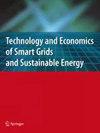ASS-MPPT and 2TSO Algorithm-Based Design and Evaluation of a Wind-Biomass Hybrid Power Generation Systems
IF 1.5
Q4 ENERGY & FUELS
Technology and Economics of Smart Grids and Sustainable Energy
Pub Date : 2023-11-06
DOI:10.1007/s40866-023-00177-y
引用次数: 0
Abstract
The utilization of conventional sources augments the demand for energy, thus resulting in the usage of Renewable Energy Sources (RESs). It is convenient to add another energy source to solar along with wind energy sources since these RESs could not be tapped continuously. Fulfilling the electric load demands with higher unpredictability might not be practical with stand-alone energy systems. Thus, to overcome the stand-alone energy systems’ weaknesses, it would be highly significant to amalgamate one or more energy systems. To provide expanded system effectiveness together with a greater balance in power supply, generally, two or more energy sources are comprised in a Hybrid Renewable Energy System (HRES). To produce electricity, the energy from wind and biomass is utilized in the proposed methodology. The rectifier is utilized with the inverter since the inverter operates with the DC input source. The Adjustable Step Size Maximum Power Point Tracking (ASS-MPPT), which regulates the output voltage by tuning the pulse width, is deployed in the inverter to attain a response for power control. By amalgamating the generation energy from wind as well as biomass systems, a Hybrid Power Generation System (HPGS) has been proposed. In the experimental evaluation, the technical feasibility of incorporating wind along with biomass systems for the needed demand has been analyzed. The experiential outcomes proved that to gratify the energy demands, higher efficiency could be delivered by the proposed hybrid system.基于ASS-MPPT和2TSO算法的风能-生物质混合发电系统设计与评价
传统能源的利用增加了对能源的需求,从而导致使用可再生能源。在太阳能和风能之外增加另一种能源是很方便的,因为这些RESs不能连续使用。对于独立的能源系统来说,满足具有较高不可预测性的电力负荷需求可能是不切实际的。因此,为了克服独立能源系统的弱点,合并一个或多个能源系统将是非常重要的。为了提供更大的系统效率和更大的电力供应平衡,通常,混合可再生能源系统(HRES)由两种或更多的能源组成。在提出的方法中,利用风能和生物质能来发电。整流器与逆变器一起使用,因为逆变器与直流输入源一起工作。可调步长最大功率点跟踪(ASS-MPPT),通过调整脉冲宽度来调节输出电压,部署在逆变器中以获得功率控制的响应。结合风能和生物质能发电系统,提出一种混合发电系统(HPGS)。在实验评估中,分析了将风能与生物质系统结合以满足需求的技术可行性。实验结果表明,在满足能源需求的前提下,所提出的混合动力系统可以提供更高的效率。
本文章由计算机程序翻译,如有差异,请以英文原文为准。
求助全文
约1分钟内获得全文
求助全文
来源期刊

Technology and Economics of Smart Grids and Sustainable Energy
Economics, Econometrics and Finance-Economics and Econometrics
CiteScore
3.90
自引率
18.20%
发文量
33
 求助内容:
求助内容: 应助结果提醒方式:
应助结果提醒方式:


